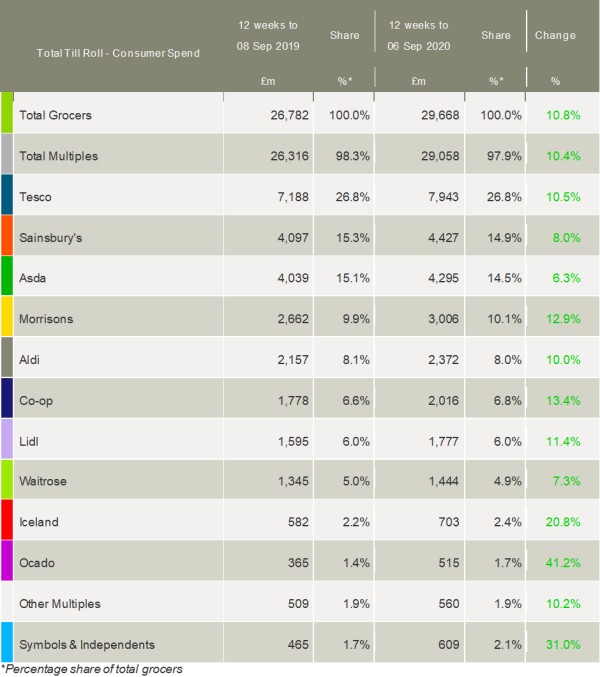Latest grocery market share figures from Kantar show year-on-year sales growth in August decelerated to 8.0%, the slowest rate since April as some aspects of pre-Covid life resumed, particularly eating out.
Take-home grocery sales for the longer 12-week period to 6 September rose by 10.8% – marking the sector’s fifth consecutive period of double-digit growth with most chains continuing to prosper.
Fraser McKevitt, head of retail and consumer insight at Kantar, commented: “Grocery growth tailed off in August as the Government’s Eat Out to Help Out scheme got underway and people were encouraged to return to offices and resume normal routines. Diners’ confidence built throughout the month and footfall increased during each week of the scheme, culminating in the final bank holiday Monday when dining out accounted for a two and a half times greater share of consumer spend than the pre-Covid average.”
Kantar’s data shows that fewer meals eaten at home meant consumers spent £155m less in the supermarkets in the four weeks to 6 September compared with July. Alcohol sales dipped month-on-month, with wine down 5% and beer down 10%, as the scheme encouraged people to venture out to bars and restaurants. This appears to have reignited personal grooming routines with sales of hair styling products 17% higher in August than July, hair removal treatments up by 11%, and deodorants increasing by 3%.
Meanwhile, online grocery sales rose by 77% year-on-year in the past four weeks, bringing the cumulative increase in orders to £3.2bn since lockdown began. McKevitt commented: “While online grocery growth is still impressive, it has slowed for the second month in a row and dropped back to 12.5% of total sales this month from a peak of 13.5%. This is not just about people going out to eat in restaurants, August also brought shielding to an end for many vulnerable and at-risk people.”
Ocado, which launched its product partnership with Marks & Spencer’s on 1 September, was the fastest-growing retailer over the 12 week period, with sales up by 41.2% year-on-year. Its former partner, Waitrose, increased overall sales by 7.3% compared with last year, and Waitrose.com experienced the fastest year-on-year online growth of any retailer.
Amid a challenging economic climate, Kantar highlighted that retailers across the board are finding new ways to deliver value for customers. Promotional activity is now back to the highest level since February and is focused mainly on straightforward price cuts, with shoppers spending £247m more on these deals compared with a year ago. Meanwhile, multibuy deals are down £116m over the same period.
McKevitt added: “We expect loyalty schemes to become increasingly important in the months ahead. 26 million British shoppers hold at least one supermarket loyalty card, with the average person carrying three in their wallet. Lidl launched its ‘Lidl Plus’ loyalty app in the UK last month and Tesco, which runs the single biggest scheme with ‘Clubcard’, continues to launch new discounts through the programme.”
Lidl increased its sales by 11.4% and Tesco by 10.5% over the 12 weeks and both retailers held market share year-on-year.
Iceland continued to benefit from the increased demand for frozen food this year and grew sales by 20.8%, achieving a 2.4% market share, up from 2.2% last year. Aldi increased sales by 10.0%, with its market share slightly down on last year to 8.0%.
Sales at Co-op rose by 13.4% but increased by more than double this rate in the North of England, where local lockdowns meant consumers are continuing to shop closer to home. Meanwhile, symbols and independent retailers saw sales rise by 31%. While shopper numbers were down by 2.3m from the May-lockdown peak, those customers still visiting spent £131 on average over the 12 weeks, £24 more than the same time last year.
Morrisons’ sales rose by 12.9%, with market share up by 0.2 percentage points to 10.1%. Sainsbury’s and Asda’s sales increased by 8.0% and 6.3% respectively.
Meanwhile, Kantar’s data shows that grocery inflation stood at 2.3% over the 12-week period. Prices rose fastest in markets such as ice cream, colas and fresh bacon, and fell in fresh poultry, vegetables and toilet tissues.

NAM Implications:
- Hospitality and office working were always due to revert to pre-lockdown levels, in part.
- The key is to what extent…
- Stakeholders need to conduct ‘what-ifs’ re hospitality and home working in order to evolve realistic strategies.
- How about Hospitality at 30% down
- And 20% home working permanently?




